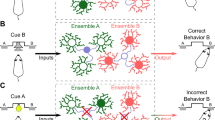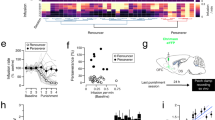Abstract
Understanding the neurobiology of motivation might help in reducing compulsive behaviors such as drug addiction or eating disorders. This study shows that excitatory synaptic transmission was enhanced in the bed nucleus of the stria terminalis of rats that performed an operant task to obtain cocaine or palatable food. There was no effect when cocaine or food was delivered passively, suggesting that synaptic plasticity in this area is involved in reward-seeking behaviors.
This is a preview of subscription content, access via your institution
Access options
Subscribe to this journal
Receive 12 print issues and online access
$209.00 per year
only $17.42 per issue
Buy this article
- Purchase on Springer Link
- Instant access to full article PDF
Prices may be subject to local taxes which are calculated during checkout


Similar content being viewed by others
References
Markou, A. et al. Psychopharmacology (Berl.) 112, 163–182 (1993).
Deroche-Gamonet, V., Belin, D. & Piazza, P.V. Science 305, 1014–1017 (2004).
Malenka, R.C. & Nicoll, R.A. Science 285, 1870–1874 (1999).
Dong, H.W. & Swanson, L.W. J. Comp. Neurol. 468, 277–298 (2004).
Delfs, J.M., Zhu, Y., Druhan, J.P. & Aston-Jones, G. Nature 403, 430–434 (2000).
Erb, S., Salmaso, N., Rodaros, D. & Stewart, J. Psychopharmacology (Berl.) 158, 360–365 (2001).
Walker, J.R., Ahmed, S.H., Gracy, K.N. & Koob, G.F. Brain Res. 854, 85–92 (2000).
Kelley, A.E. Neurosci. Biobehav. Rev. 27, 765–776 (2004).
Phillipson, O.T. J. Comp. Neurol. 187, 117–143 (1979).
Ungless, M.A., Whistler, J.L., Malenka, R.C. & Bonci, A. Nature 411, 583–587 (2001).
Borgland, S.L., Malenka, R.C. & Bonci, A. J. Neurosci. 24, 7482–7490 (2004).
Dumont, E.C. & Williams, J.T. J. Neurosci. 24, 8198–8204 (2004).
Georges, F. & Aston-Jones, G. J. Neurosci. 22, 5173–5187 (2002).
Author information
Authors and Affiliations
Corresponding author
Ethics declarations
Competing interests
The authors declare no competing financial interests.
Supplementary information
Rights and permissions
About this article
Cite this article
Dumont, E., Mark, G., Mader, S. et al. Self-administration enhances excitatory synaptic transmission in the bed nucleus of the stria terminalis. Nat Neurosci 8, 413–414 (2005). https://doi.org/10.1038/nn1414
Received:
Accepted:
Published:
Issue Date:
DOI: https://doi.org/10.1038/nn1414
This article is cited by
-
Ethanol-induced conditioned place preference and aversion differentially alter plasticity in the bed nucleus of stria terminalis
Neuropsychopharmacology (2019)
-
Visceral adiposity and insular networks: associations with food craving
International Journal of Obesity (2019)
-
The Effects of Prior Stress on Anxiety-Like Responding to Intra-BNST Pituitary Adenylate Cyclase Activating Polypeptide in Male and Female Rats
Neuropsychopharmacology (2017)
-
Opiate dependence induces cell type-specific plasticity of intrinsic membrane properties in the rat juxtacapsular bed nucleus of stria terminalis (jcBNST)
Psychopharmacology (2017)
-
Pharmacology of the Bed Nucleus of the Stria Terminalis
Current Pharmacology Reports (2016)



